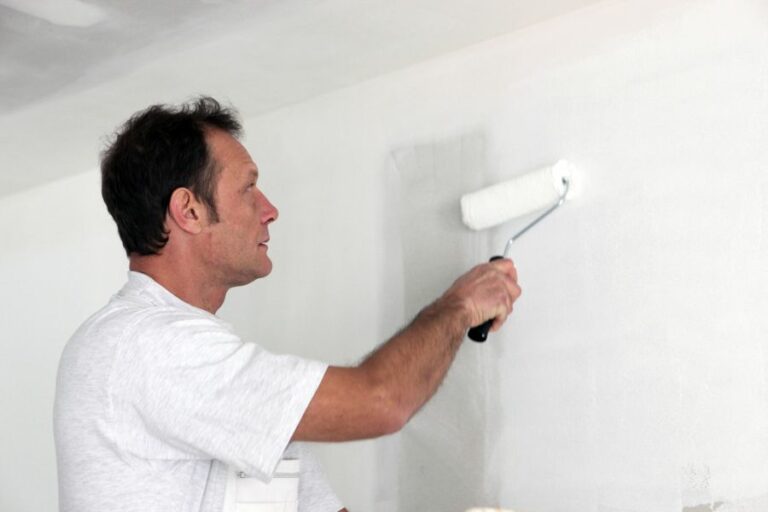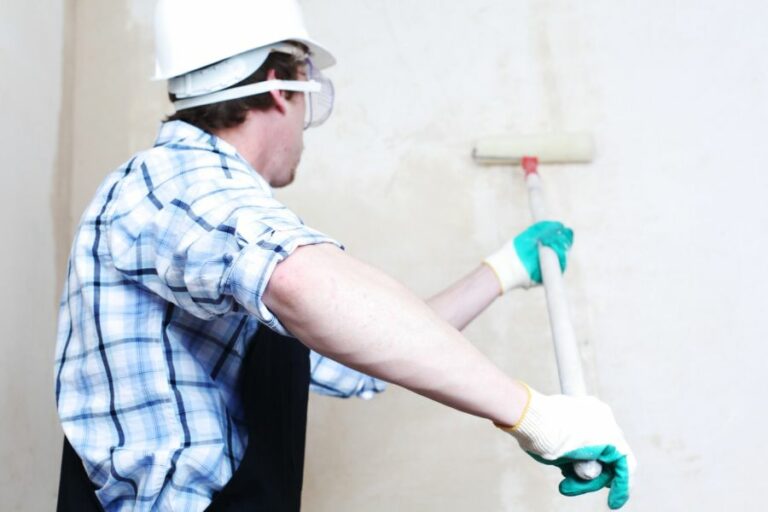Key Steps To Ensure Successful Repainting Jobs, What Pros Say
Are you planning to give your space a fresh look with a repainting job? Well, you’ve come to the right place! We know how crucial it is to have that perfect paint job, and we’re here to guide you through the key steps to ensure a successful outcome. Follow these essential tips, and you’ll soon be enjoying the beautiful transformation that a well-executed repainting job can bring to your home or office.
Key steps to ensure successful repainting jobs:
To ensure a successful repainting job, follow these key steps: choose high-quality materials such as Sherwin-Williams or Benjamin Moore paints; properly prepare the surface by cleaning, repairing, sanding, and priming; use appropriate painting techniques like proper mixing, cutting in, roller application, and multiple coats, and conduct a final inspection and touch-ups as needed.

Ready to give your space a fresh new look? Our guide on ‘Key steps to ensure successful repainting jobs’ has got you covered. Keep reading to unveil essential tips and tricks that guarantee flawless and lasting results!
Contents
- 1 Essential Steps for Achieving Flawless Repainting Projects
- 2 Tips to Guarantee a High-Quality Paint Finish
- 3 Strategies to Boost Success in Your Painting Enterprise
- 4 Criteria for Determining a Top-Notch Painted Outcome
- 5 Evaluating Paintwork: Key Factors to Consider
Essential Steps for Achieving Flawless Repainting Projects
• Choosing the Right Materials
Using high-quality paints and primers is crucial for ensuring a successful repainting job. Poor-quality paints may come at a lower price, but they often have a shorter lifespan and require more coats, leading to added costs in terms of labor and materials.
– Recommendation:
From my experience, I recommend choosing well-known, reputable brands like Sherwin-Williams or Benjamin Moore to ensure optimal results.
• Proper Surface Preparation
Preparing the surface correctly is crucial for the success of any repainting job. The process ensures that the new paint adheres to the surface properly and that it can withstand environmental factors, such as changing temperatures, UV exposure, or fluctuating humidity levels.
– Steps for thorough surface preparation:
- Cleaning: Remove any dirt, grease, or contaminants by washing the surface thoroughly. Use an appropriate cleaning solution and scrub the surface with a stiff bristle brush. Rinse with clean water and let the surface dry.
- Repairing: Inspect the surface for any cracks, holes, loose or peeling paint, and other imperfections. Fill any gaps with suitable filler or caulk and sand smooth when dry.
- Sanding: Sand the surface once its clean and dry, using appropriate grit sandpaper or a power sander. This process will improve paint adhesion and ensure a smooth final appearance.
- Priming: Apply a high-quality primer to the surface, ensuring complete coverage. This basecoat will help the paint bond to the substrate, providing improved adhesion, durability, and overall appearance.
• Proper Painting Techniques
Employing appropriate painting techniques is essential for achieving professional-looking results. This encompasses everything from paint mixing methods to properly applying paint to the surface.
– Steps to follow for expert painting techniques:
- Paint mixing: Before painting, mix the paint thoroughly. If the paint has been sitting for an extended period, the pigments and binders may have separated. Stir the paint until you achieve a consistent texture and color throughout the container.
- Cutting in: Start painting by cutting in around the edges and corners of the room or object being painted. This involves painting a smooth, straight line along the border, which will make it easier for you to fill in the remainder of the area with a roller. Use an angled brush or a paint edger for this step.
- Roller techniques: When using a roller, apply consistent pressure and roll in a “W” or “M” pattern, avoiding straight lines up and down. Working in small sections ensures even and proper coverage for a smooth finish.
- Multiple coats: For the best results, apply multiple coats of paint, allowing each to dry according to the manufacturer’s instructions. This process ensures even coverage, durability, and an exceptional final appearance.
- Proper brush and roller care: Clean your brushes and rollers thoroughly after each use, ensuring all paint has been removed from their fibers. This will prolong their lifespan and maintain their performance for future projects.
• Final Inspection and Touch-up
Once the painting is complete, conduct a thorough inspection of the area to identify any imperfections or missed spots. Touch-up any areas that require attention, ensuring consistent color and coverage.
– Tips for effective touch-ups:
- Use the same paint: Make sure to use the same paint batch used for the initial painting to ensure a uniform color match.
- Employ the same applicator: When possible, use the same brush or roller that you used initially, as varying applicators may produce different textures on the surface.
- Blend: To ensure seamless blending with the surrounding paint, feather out the edges of the touch-up area with a brush or roller.
In conclusion, ensuring successful repainting jobs involves careful preparation, selecting high-quality materials, employing proper painting techniques, and conducting thorough inspections upon completion.
By adhering to these steps, you’ll achieve professional-looking results that will stand the test of time.
Tips to Guarantee a High-Quality Paint Finish
A good paint job can transform your living space, providing a fresh and appealing look. However, achieving a professional finish requires a combination of careful preparation, appropriate materials, and proper technique.
• Preparing the Surface
Before you even consider the paint and brushes, it’s crucial that the surface you’re painting is adequately prepared. There are several key steps to take when preparing a surface for painting.
– Cleaning and Dusting
The first step is to thoroughly clean and dust the surface. Any dirt, grease, or dust on the wall can significantly impact the adhesion and finish of the paint.
A simple solution of warm water and mild dish soap should suffice for cleaning most surfaces, followed by a thorough rinse with clean water. For areas with stubborn grease or dirt, a trisodium phosphate (TSP) solution may be required.
TSP is available at most home improvement stores and can be mixed according to the package instructions. Be sure to wear gloves and eye protection when handling TSP. For more information on TSP, you can visit this EPA webpage on trisodium phosphate (TSP).
– Filling Cracks and Holes
Once the surface is clean and dry, the next step is to fill any cracks or holes with appropriate fillers. For small holes and gaps, a lightweight spackle or pre-mixed joint compound will suffice.
For larger holes or cracks, a patching compound or joint compound mixed with a setting-type compound will provide a stronger and more durable fix. After applying the filler, sand the area smoothly and flush with the surrounding surface.
– Sanding and Priming
Sanding the entire surface to be painted is a crucial step in ensuring good paint adhesion. Using fine-grit sandpaper (120 to 180 grit), sand the surface in a circular motion.
This helps create a slightly rough and scuffed surface that allows the paint to adhere better. After sanding, remove any remaining dust using a microfiber cloth or vacuum.
Priming the surface is essential, especially when working with new drywall or when painting over dark or bold colors. Primers help seal porous surfaces and provide a uniform base for the paint to adhere to.
Additionally, there are specialized primers that can block stains or odors, so it’s essential to choose the correct primer for your project.
• Selecting the Right Paint and Supplies
– Choosing the Right Paint
The quality of the paint you choose is incredibly important. High-quality paint offers better coverage, durability, and overall results.
When selecting paint, consider factors such as the sheen (flat, eggshell, satin, semi-gloss, or gloss), the type of paint (latex or oil-based), and the specific paint brand.
Researching customer reviews and consulting consumer testing websites can provide insight into the best options for your particular project.
– Brushes and Rollers
The quality of your brushes and rollers is also essential in achieving a professional finish. Invest in high-quality brushes and rollers appropriate for the type of paint you are using.
For example, synthetic brushes (made of nylon, polyester, or a blend) are best for latex paints, while natural-bristle brushes are best for oil-based paints.
In addition to the brush material, pay attention to the brush’s bristle profile. Angled sash brushes offer better control and precision when cutting in (painting the edges and corners), while flat brushes provide better coverage on larger areas.
• Proper Painting Technique
– Cutting in and Rolling
Begin by “cutting in,” which involves painting the areas along the edges, corners, and trim that cannot be reached with a roller. Use an appropriately sized angled sash brush with steady, controlled strokes, being careful not to overload the brush with paint.
After cutting in, use a roller to paint the larger surface areas. Start by rolling in a “W” or “M” pattern, and then fill in the unpainted areas using the roller.
This helps to evenly distribute the paint and reduce lap marks. Also, make sure to blend in with the areas where you cut in to achieve a seamless appearance between brushwork and roller work.
– Proper Paint Application
Avoid applying too much or too little paint to the surface. If the paint is applied too thickly, tension cracks and runs can occur. If applied too thinly, it can result in patchy coverage and poor durability. The key is to maintain a consistent and even coat of paint.
Several thin coats of paint are better than one thick coat. Allow the paint to dry thoroughly between coats and follow the paint manufacturer’s guidance on dry times and recoating.
– Maintaining a Wet Edge
To achieve a uniform and seamless finish, it is crucial to maintain a “wet edge” as you paint. This means painting adjacent sections before the paint has dried to avoid creating areas of overlapping or streaks. When cutting in, try to work in sections that can be rolled before the brushed paint dries.
• Final Thoughts
A good paint job relies on a combination of proper preparation, quality materials, and appropriate techniques. By following the steps and recommendations outlined in this article, you can ensure a professional, long-lasting, and impressive paint job.
Remember that practice makes perfect, and don’t be afraid to consult expert resources or local professionals if you need additional guidance. Happy painting!
Steps | Description |
|---|---|
1. Surface Preparation | Clean and remove dirt, grease, or any loose paint from the surface. Sand or scrape any rough areas to create a smooth surface for painting. |
2. Choose the Right Paint and Tools | Select the appropriate paint for your surface and purpose. Choose high-quality brushes, rollers, and other painting tools for the best results. |
3. Prime the Surface | Apply primer to the surface, particularly on areas with stains, bare wood, or any repaired spots. This will help the paint adhere better and improve the overall appearance of the paint job. |
4. Apply the Paint in Thin, Even Coats | Start by cutting in the edges with a brush, then use a roller to apply the paint in overlapping W or M patterns. Make sure to apply thin, even coats to avoid drips or uneven coverage. |
5. Allow Proper Drying Time between Coats | Follow the recommended drying time on the paint can to ensure a proper bond between the layers. |
6. Clean Up and Dispose of Tools Properly | Clean brushes, rollers, and other tools with the appropriate cleaning solution (water or paint thinner) and dispose of any used paint or materials according to local regulations. |
Strategies to Boost Success in Your Painting Enterprise
Starting and running a successful painting business is not an easy task. With the right skills, dedication, and planning, you can establish a profitable business that provides quality services for your clients.
• Develop Essential Skills and Knowledge
A strong foundation in the basics of painting and project management is vital for running a successful painting business. Ensure that you and your employees are well-versed in various painting techniques, surface preparation, color matching, and safety procedures.
Consider taking courses, attending workshops, and obtaining certifications to enhance your skills and credibility.
– Recommendation: Stay Current with Industry Trends
It’s essential to stay up-to-date with the latest trends in painting technology, materials, and designs. Attend industry events, subscribe to trade magazines, and follow popular blogs to stay informed and bring the latest innovations to your clients.
• Effective Business Planning
A well-defined business plan is a critical component to ensure the long-term success of your painting business.
Your plan should outline your target market, pricing strategy, competitive analysis, financial projections, and marketing efforts. Revisit and update your business plan regularly as your company grows and evolves.
– Recommendation: Secure Adequate Financing
Evaluate your financial needs and plan for unexpected expenses. Apply for business loans, credit lines, and other forms of financing to ensure you have the funds needed to support your enterprise.
• Excellent Customer Service
Superior customer service is key to building a solid reputation and attracting repeat clients. Promptly respond to inquiries, provide accurate quotes, arrive on time, and maintain open communication throughout the project.
Be sure your employees are also trained in providing exceptional customer service.
– Recommendation: Collect Client Feedback
Request feedback from your customers to identify areas of improvement and opportunities for growth. Use positive reviews as testimonials on your website and marketing materials to attract more business.
• Efficient Operations and Project Management
Effective project management ensures that your painting projects are completed on time, within budget, and to your client’s satisfaction.
Maintain accurate records, invest in workforce management software, and regularly audit your processes to optimize efficiency.
– Recommendation: Build a Reliable Team
Hire skilled and experienced painters to ensure quality workmanship. Invest in their training and development and foster a positive work environment to retain top talent.
• Comprehensive Insurance and Licensing
Acquire the necessary licenses, permits, and insurance coverage required for painting businesses in your region.
This establishes credibility with potential clients and protects your business from unforeseen liabilities. Requirements may vary, so consult relevant government agencies for specific guidelines.
– Recommendation: Join Professional Associations
Participate in industry groups like the Painting Contractors Association (PCA) to gain access to resources, networking opportunities, and credibility.
Displaying membership logos on your marketing materials demonstrates a commitment to professionalism and quality service.
• Strategic Marketing and Promotion
Effectively promote your painting business through targeted marketing strategies, including traditional advertising (print and radio), digital marketing (websites, email campaigns, and social media), and local promotions (sponsorships, community events, and collaborations).
Monitor the return on investment of your marketing efforts to ensure they contribute to your business growth.
– Recommendation: Cultivate a Strong Online Presence
Create a professional and user-friendly website that showcases your work, offers a clear value proposition, and provides contact information.
Cultivate a positive online reputation by monitoring and promptly responding to reviews and inquiries on social media and review platforms.
• Establish Competitive Pricing and Quality Offerings
Determine the appropriate pricing for your services, considering factors such as target audience, competition, and market rates.
Strive to deliver high-quality services that justify your prices and differentiate you from competitors. This combination will establish your reputation for excellent value and expertise.
– Recommendation: Offer Customer Incentives
Consider implementing special offers, discounts, and referral programs to attract new customers and build loyalty among existing clients. Incentives like free color consultations, seasonal specials, or multi-room discounts can provide a competitive edge.
In conclusion, a successful painting business can be achieved through a combination of industry expertise, effective planning, exceptional customer service, efficient operations, comprehensive licensing and insurance, strategic marketing, and competitive pricing.
Implementing these strategies while staying informed of industry trends will lead to a prosperous and enduring enterprise.
Criteria for Determining a Top-Notch Painted Outcome
A high-quality paint job is a combination of appropriate preparation, material selection, and proper application techniques.
• Surface Preparation
Proper surface preparation is the first step toward achieving a high-quality paint job. Some aspects to look for include:
– Cleaning and Degreasing
Any contaminants on the surface can lead to adhesion problems, as well as other defects like fisheyes, craters, or uneven sheen. Therefore, thoroughly cleaning and degreasing the surfaces is essential.
– Sanding and Smoothing
A well-prepared surface should be free of rough spots, imperfections, and visible brush or roller marks. Sanding and smoothing ensure optimal adhesion of the paint and contribute to an even appearance.
– Priming
A high-quality paint job typically includes the use of a suitable primer. Priming can help to improve adhesion, hide surface imperfections, and provide a consistent base for the finishing coats.
• Paint Selection
Choosing the right paint is crucial for achieving a high-quality finish. When assessing a paint job, consider the following:
– Paint Type
The type of paint can impact the final finish. For instance, water-based paints tend to dry faster and produce fewer odors, whereas oil-based paints generally provide a smoother, more durable finish.
– Sheen Level
The sheen level of a paint job should be appropriate for the specific surface and desired appearance. For instance, a high-gloss finish may be suitable for trims and doors, whereas a matte finish may be more appropriate for walls and ceilings.
– Color Consistency
A well-executed paint job should have consistent color throughout the surface without any noticeable color variations or patchiness.
• Application Techniques
The techniques employed when applying paint can significantly impact the overall quality of the finished product. Some key factors to observe include:
– Brushwork and Roller Marks
In a high-quality paint job, brush and roller marks should be minimal, with no visible lines, streaks, or clumps of paint.
– Proper Coverage
The paint should be evenly distributed on the surface, with no apparent thin spots or overlaps. This indicates that the painter has applied the appropriate number of coats of paint to achieve an even finish.
– Crisp Edges
When evaluating a paint job, pay attention to the edges and corners of the painted area. A skilled painter will achieve crisp, clean edges without smudges, drips, or noticeable overlaps onto adjacent surfaces.
– Absence of Defects
A high-quality paint job should be free of common paint defects such as chipping, peeling, or cracking. Issues like sagging, paint runs, and blisters are also indicative of subpar workmanship or improper surface preparation.
• Durability
Lastly, a quality paint job should also be able to stand the test of time. Aspects to consider include:
– UV Resistance
A durable paint job should show minimal signs of fading or discoloration due to sunlight exposure.
– Wear and Tear Resistance
Well-executed paint jobs should be able to withstand minor wear and tear without showing signs of damage or wear.
– Cleanability
A high-quality paint job will also be easy to clean and maintain without causing damage to the painted surface.
In conclusion, carefully assessing the quality of a finished paint job involves examining the surface preparation, paint selection, application techniques, and durability of the final product.
By keeping these quality requirements in mind, you can ensure a successful and lasting paint job for your home or property.
| Criteria for Determining a Top-Notch Painted Outcome |
|---|
| Smooth and even surfaces |
| No visible brush marks or roller marks |
| No drips, runs or sags |
| Consistent color and sheen |
| Properly coated edges and corners |
| No visible patches or uneven coverage |
| Durability and resistance to chipping, peeling, and fading |
| Neat and precise lines between different paint colors or finishes |
| Proper surface preparation and primer application |
| Cleanup and proper disposal of materials |
Evaluating Paintwork: Key Factors to Consider
• Introduction
A paint job can make or break the appearance of any structure, be it a residential house or a commercial building. As a professional painter with years of experience under my belt, I understand the importance of assessing the quality of a paint job.
• Evaluating Surface Preparation
1. Cleaning
A crucial factor in the success of any paint job is the cleanliness of the surface being painted. Before paints are applied, the surface should be free of dirt, grease, and other contaminants that can inhibit paint adhesion.
A good paint job would involve thorough surface cleaning, ensuring that the paint will adhere correctly.
2. Sanding
Sanding the surface is equally important in order to achieve a smooth finish. A professional paint job always includes proper sanding to remove any old paint or imperfections and to promote adhesion.
Check for a uniform sanded appearance and ensure that there are no rough spots or uneven areas.
3. Primer Application
Priming is another essential aspect of surface preparation. A good paint job should show that a suitable primer was applied to help promote adhesion, durability, and overall appearance. Check for even coverage and consistency of the primer, which will indicate a well-executed job.
• Assessing Paint Quality
4. Paint Selection
The quality of paint being used plays a crucial role in the overall success of a paint job. Good paint jobs involve using high-quality paint with greater durability, coverage, and color retention.
Additionally, the selected paint should have the appropriate sheen, type, and color for the specific surfaces and conditions they will face.
5. Consistency of Paint Coverage
Proper application of paint is fundamental in achieving a quality paint job. Look closely at the painted surfaces to see if there are any areas where the paint appears too thick, too thin, or uneven.
Consistency in paint coverage ensures that the entire surface looks and performs well over time.
6. Opacity and Color Uniformity
A well-done paint job should have even opacity and color distribution across the entire surface. Check for any areas where the underlying surface may be visible or where the color looks inconsistent. This could indicate improper application techniques or inadequate paint coverage.
• Identifying Common Flaws
7. Paint Runs and Sags
One of the most obvious signs of a poor paint job is the presence of paint runs or sags. This typically occurs when paint is applied too heavily or the surface is not adequately prepared.
Keep an eye out for any areas where the paint appears to have dripped or sagged, as this can significantly detract from the overall appearance.
8. Brush and Roller Marks
A skilled painter will utilize proper techniques to minimize visible brush and roller marks. Examine the painted surface, specifically around edges or where different surfaces meet, as these areas are often the most prone to uneven application.
If you can spot distinct brush or roller marks, the paint job may not be up to par.
– 9. Blemishes and Imperfections
Lastly, look for any blemishes, such as bubbles, cracks, or debris in the paint. These imperfections can indicate that the surface was not adequately prepared or that the paint application was rushed. A high-quality paint job should not exhibit these flaws.
• Conclusion
In summary, judging a paint job involves considering various factors, including proper surface preparation, the quality of the paint used, consistent paint coverage, and the presence of any visible flaws or imperfections.
By closely examining a paint job using these criteria, you can assess its quality and ensure that the end result is both visually appealing and long-lasting.
I highly recommend taking the time to thoroughly evaluate any paint job, as the appearance and longevity of your structure depend on the quality of the work done.
Criteria | Description |
|---|---|
Surface preparation | Check for proper cleaning, sanding, and priming of the surface before painting. |
Evenness of paint application | Ensure that the paint has been applied uniformly, without streaks, roller marks, or brush strokes. |
Color consistency | Verify that the color matches the intended shade and is consistent throughout the painted area. |
Edge quality | Inspect the edges near moldings, windows, and doors to ensure clean, precise lines without overlapping or paint bleeding. |
Number of coats | Review whether the appropriate number of coats has been applied to achieve proper coverage and finish. |
Durability | Assess the paint’s resistance to damage, fading, and wear, as it signifies a high-quality paint job. |
Cleanup | Check for any paint spills, splatters, or debris left from the painting process. |







